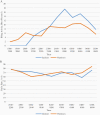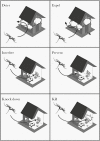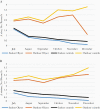Review of Issues on Residual Malaria Transmission
- PMID: 33906221
- PMCID: PMC8079138
- DOI: 10.1093/infdis/jiab084
Review of Issues on Residual Malaria Transmission
Abstract
Residual malaria transmission is the actual maintained inoculation of Plasmodium, in spite of a well-designed and implemented vector control programs, and is of great concern for malaria elimination. Residual malaria transmission occurs under several possible circumstances, among which the presence of exophilic vector species, such as Anopheles dirus, or indoor- and outdoor-biting vectors, such as Anopheles nili, or specific behavior, such as feeding on humans indoors, then resting or leaving the house the same night (such as Anopheles moucheti) or also changes in behavior induced by insecticides applied inside houses, such as the well-known deterrent effect of permethrin-treated nets or the irritant effect of DDT. The use of insecticides may change the composition of local Anopheles populations, such as A. arabiensis taking up the place of A. gambiae in Senegal, A. aquasalis replacing A. darlingi in Guyana, or A. harrisoni superseding A. minimus in Vietnam. The change in behavior, such as biting activity earlier than usually reported-for example, Anopheles funestus after a large-scale distribution of long-lasting insecticidal nets-or insecticide resistance, in particular the current spread of pyrethroid resistance, could hamper the efficacy of classic pyrethroid-treated long-lasting insecticidal nets and maintained transmission. These issues must be well documented in every situation to elaborate, implement, monitor, and evaluate tailored vector control programs, keeping in mind that they must be conceived as integrated programs with several well and appropriately coordinated approaches, combining entomological but also parasitological, clinical, and social methods and analyses. A successful integrated vector control program must then be designed to reduce transmission and incidence rates of malaria morbidity and overall mortality.
Keywords: Residual malaria transmission; outdoor biting behavior; vector behavior changes; vector control methods.
© World Health Organization, 2021. All rights reserved. The World Health Organization has granted the Publisher permission for the reproduction of this article.
Figures















References
-
- World Health Organization. World malaria report. Geneva, Switzerland: World Health Organization, 2015.
-
- World Health Organization. World malaria report. Geneva, Switzerland: World Health Organization, 2017.
-
- Durnez L, Coosemans M. Residual transmission of malaria: an old issue for new approaches. In: Manguin S, ed. Anopheles mosquitoes—new insights into malaria vectors. Rijeka, Croatia: IntechOpen, 2013:671–704.
-
- Gillies MT, De Meillon B. The Anophelinae of Africa South of the Sahara: Ethiopian zoogeographical region. South Afr Inst Med Res 1968;54:1–343.
Publication types
MeSH terms
Substances
LinkOut - more resources
Full Text Sources
Other Literature Sources
Medical
Miscellaneous

